要因とアウトカムの関連性を分析する研究
新しく開発された治療は、臨床試験という方法でそれが有効かどうかが研究されます。一方、病気や障害と他の病気や生活習慣との関係を探ったり、また、検査・治療・ケアを組み合わせた診療パターンが患者の健康とどのように関連するかを調べたりするためには、臨床試験ではなく観察研究(医療現場での実態を記録する方法)を行う必要があります。
MBD-5D研究
透析を受けている患者さんでは、高率に骨代謝の異常が発生します。MBD-5D研究(*1)は、80以上の透析医療機関において、骨代謝の異常のある透析患者さん約8,000名を対象に、診療パターンと患者健康との関連を調べる研究です。研究のデザインは、比較的少ないコストで多くの患者さんをカバーできるように工夫されています。iHopeはMBD-5D研究において、研究計画の立案とデータの解析をサポートしています。
*1)Mineral and Bone Disorders Outcomes Study for Japanese CKD Stage 5D Patients(透析MBDアウトカム研究)
- ■概要
-
- 二次性副甲状腺機能亢進症を対象とするアウトカム研究
- 日本の患者8,229名を対象とする3年間の前向き観察研究
- 13報(2016年末時点)の論文を国際医学雑誌に発表
- ■背景
- 慢性腎臓病(CKD)患者における骨ミネラル代謝の異常は、骨の病変を生ずるだけでなく、生命予後にも影響を及ぼすことが注目されてきた。その結果、全身疾患としての「CKDに伴う骨ミネラル代謝異常(CKD-MBD)」という新たな概念が提唱されている。
二次性副甲状腺機能亢進症(SHPT)は、CKD-MBDの中でも頻度が高い病態である。CKDの進行に伴って、血中のリン、カルシウム、副甲状腺ホルモン(PTH)の異常が生じ、骨や心血管系の障害につながる。
2006年に「透析患者における二次性副甲状腺機能亢進症治療ガイドライン」が一般社団法人 日本透析医学会から公表された。本ガイドラインでは、生命予後の改善を目的として、各検査値の目標値や推奨される治療が設定された。しかしながら、これまで日本人のデータに基づくエビデンスは十分ではなく、特に生命予後改善に関するエビデンスが必要とされていた。
以上の背景から、2008年より、患者アウトカムの向上に資する情報を生み出し、当該領域の医療の向上に貢献すべく、SHPTを有する血液透析患者を対象とした透析MBDアウトカム研究(MBD-5D研究)が実施された。
- ■研究の目的
-
- 患者プロフィルおよび診療パターンのばらつきを記述する
- 診療パターンのばらつきの要因を分析する
- 死亡や入院をはじめとする患者アウトカムに影響を及ぼす診療パターンやその他の要因を同定する
- ■研究デザインの特徴
-
- 大規模
当該疾患を有する日本国内の患者の約10%を対象とする大規模な研究である。 - 患者負担なし
日常診療で発生する既存データのみを対象とした観察研究であり、患者負担は一切ない。 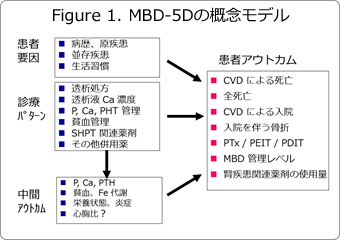 多目的
多目的
診療パターン、患者予後を含む種々の因子間の関連を解明できるよう計画されている(「Figure 1. MBD-5Dの概念モデル」参照)。- 事前仮説に基づく検討
以下の5つのリサーチ・クエスチョンを研究計画書に明示している。
(1)MBDの管理状態(Ca、P、PTH)がSHPT患者のアウトカムとどのように関連するか
(2)MBDの治療(ビタミンD製剤、リン吸着剤、カルシミメティクス)がSHPT患者のアウトカムとどのように関連するか
(3)MBD以外のどのような要因(貧血、透析条件等)がSHPT患者のアウトカムと関連するか
(4)どのような施設診療方針(MBD治療薬の使用、PTH管理目標等)がSHPT患者のアウトカムと関連するか
(5)どのような治療要因が良好なMBDの管理状態と関連するか 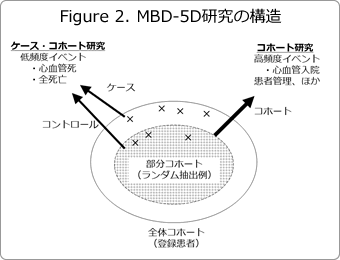 工夫された研究デザインの型
工夫された研究デザインの型
一部患者のデータから対象集団全体の結果を推定できるケース・コホート研究と通常のコホート研究とを組み合わせている(「Figure 2. MBD-5D研究の構造」参照)。
- 大規模
- ■実施概要
-
- 研究期間:2008年1月~2010年12月(3年間)
- 対象集団:SHPTを有する維持血液透析患者
- 対象施設:日本の88の透析施設
- 対象者数:8,229名
- 研究委託者:協和発酵キリン株式会社
- ■論文業績(2016/12/31現在)
-
- 英文論文11編
- 日本語論文2編
- ■研究の詳細 *クリックで詳細内容をご覧いただけます。
-
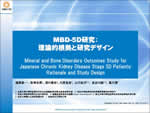 [MBD-5D研究:理論的根拠と研究デザイン]
[MBD-5D研究:理論的根拠と研究デザイン]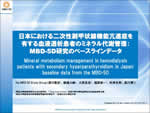 [日本における二次性副甲状腺機能亢進症を有する血液透析患者のミネラル代謝管理:MBD-5D研究のベースラインデータ]
[日本における二次性副甲状腺機能亢進症を有する血液透析患者のミネラル代謝管理:MBD-5D研究のベースラインデータ] [透析施設におけるMBD管理を中心とした診療方針調査の集計結果報告 -透析MBDアウトカム研究より-]
[透析施設におけるMBD管理を中心とした診療方針調査の集計結果報告 -透析MBDアウトカム研究より-] [透析施設におけるCKD-MBD管理を中心とした診療方針調査の終了時の集計結果報告および開始時との比較 -透析MBDアウトカム研究より-]
[透析施設におけるCKD-MBD管理を中心とした診療方針調査の終了時の集計結果報告および開始時との比較 -透析MBDアウトカム研究より-]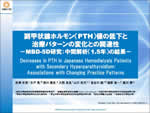 [副甲状腺ホルモン(PTH)値の低下と治療パターンの変化との関連性 -MBD-5D研究:中間解析(1.5年)の結果-]
[副甲状腺ホルモン(PTH)値の低下と治療パターンの変化との関連性 -MBD-5D研究:中間解析(1.5年)の結果-]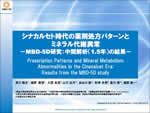 [シナカルセト時代の薬剤処方パターンとミネラル代謝異常 -MBD-5D研究:中間解析(1.5年)の結果-]
[シナカルセト時代の薬剤処方パターンとミネラル代謝異常 -MBD-5D研究:中間解析(1.5年)の結果-] [二次性副甲状腺機能亢進症を有する血液透析患者におけるミネラル代謝異常と死亡率に関する報告:周辺構造モデル(MSM)による「時間依存性交絡」調整の結果]
[二次性副甲状腺機能亢進症を有する血液透析患者におけるミネラル代謝異常と死亡率に関する報告:周辺構造モデル(MSM)による「時間依存性交絡」調整の結果]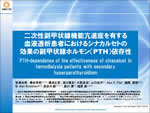 [二次性副甲状腺機能亢進症を有する血液透析患者におけるシナカルセトの効果の副甲状腺ホルモン(PTH)依存性]
[二次性副甲状腺機能亢進症を有する血液透析患者におけるシナカルセトの効果の副甲状腺ホルモン(PTH)依存性] [二次性副甲状腺機能亢進症を合併した血液透析患者のミネラル代謝の頻回モニタリング:治療目標の達成および治療の調整との関連]
[二次性副甲状腺機能亢進症を合併した血液透析患者のミネラル代謝の頻回モニタリング:治療目標の達成および治療の調整との関連]
Researches to analyze the exposure-outcome relationships
Effectiveness of a new therapy is assessed by a clinical trial, one of research designs. In contrast, an observational studies (based on data obtained in routine clinical practices rather than experiments) is indicated to explore relationships between a disease/disorder (outcome) and other diseases or life styles (exposure), as well as to investigate how the practice patterns of care (exposure) involving diagnostic tests, treatments and management cares relate to patient health (outcome).
MBD-5D Study (MBD Outcomes Study for Japanese CKD stage 5D patients)
Abnormal bone metabolisms are common in hemodialysis patients. The MBD-5D study was conducted to investigate how the practice patterns of care relate to patient health, in 8,000 hemodialysis patients having disorders of bone metabolism from more than 80 dialysis clinics/hospitals. A dedicated study design was developed to involve as many patients as possible at limited costs. iHope have contributed to planning of the study design as well as analyzing data/writing articles.
- ■Outline
-
- Outcome research in hemodialysis patients with secondary hyperparathyroidism
- Prospective, three-year, observational study on more than 8,229 patient in Japan
- 13 contributions (by the end of 2016) to international journals
- ■Background
- In patients with chronic kidiney disease (CKD), disorders of bone mineral metabolism affect not only the skeleton, but also patient survival (1–5). This understanding has led to a new concept referred to as “CKD -related Mineral and Bone Disorders” (CKD-MBD) (6), which allows for interpretation of this condition as a systemic disease.
Secondary hyperparathyroidism (SHPT) is one of the most common commodities in patients with CKD-MBD. As CKD progresses, abnormalities in the serum levels of phosphate, calcium, and parathyroid hormone (PTH) emerge (7, 8), causing disorders of bone and cardiovascular systems.
In 2006, the Japanese Society for Dialysis Therapy (JSDT) published guidelines for the treatment of SHPT in dialysis patients (11). In developing these guidelines, the JSDT placed emphasis on improving survival, and established target values for the results of laboratory tests. Nonetheless, relevant evidence based on data from Japanese patients is still insufficient. In particular, there is an obvious demand for data that could indicate improvements in survival.
In 2008, against this background, the Mineral and Bone Disorders Outcomes Study for Japanese CKD Stage 5D Patients (MBD-5D) was conducted on hemodialysis patients with SHPT, in order to deliver evidences that would contribute to improvements in the quality of care as well as patient outcomes in this medical domain.
- ■Objectives
-
- To record the characteristics of these patients and variations in the patterns of their treatment
- To analyze factors associated with variations in these medical practice patterns
- To identify the practice patterns and other factors that affect hospitalization, mortality, and other patient-level outcomes
- ■Features of the study design
-
- Large scale
Study population including 10% of the target population - No burden on study patients
An observational study using existing medical records only, demanding no patient burden 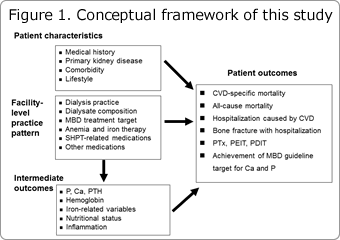 Multipurpose
Multipurpose
Designed to investigate associations among factors including patterns of care and patient outcomes (see Figure 1)- Prespecified research questions
Specifying five research questions listed below in the protocol
(1) How are Ca, P, and PTH related to outcomes in patients with SHPT?
(2) How is treatment with vitamin D, phosphorus binders, and calcimimetics related to outcomes in patients with SHPT?
(3) How are factors other than MBD (such as anemia and dialysis-related variables) related to outcomes in patients with SHPT?
(4) How are facility practice patterns (such as PTH targets and use of drugs to affect MBD) related to outcomes in patients with SHPT?
(5) Which treatments are related to good management of MBD? 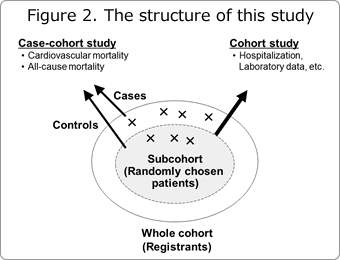 Well-devised study design
Well-devised study design
Combining two methods : (i) a case-cohort method to yield estimates for the entire population base on data from part of the population, and (ii) a conventional cohort method (see Figure 2)
- Large scale
- ■Operations
-
- Study period : January 2008 to December 2010 (3 years)
- Study population : Patients receiving maintenance hemodialysis and having SHPT
- Study sites : 88 hemodialysis facilities in Japan
- Sample size : 8,829 patients
- Sponsor : Kyowa Hakko Kirin Co., Ltd.
- ■Publications (as of December 31, 2016)
-
- Number of articles in English 11
- Number of articles in Japanese 2
- ■Research details *You can see detailed contents by clicking.
-
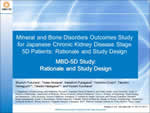 [Mineral and Bone Disorders Outcomes Study for Japanese Chronic Kidney Disease Stage 5D Patients : Rationale and Study Design]
[Mineral and Bone Disorders Outcomes Study for Japanese Chronic Kidney Disease Stage 5D Patients : Rationale and Study Design]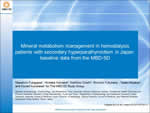 [Mineral metabolism management in hemodialysis patients with secondary hyperparathyroidism in Japan : baseline data from the MBD-5D]
[Mineral metabolism management in hemodialysis patients with secondary hyperparathyroidism in Japan : baseline data from the MBD-5D] [Results of the survey on practice patterns including MBD management at dialysis facilities : As part of the MBD-5D]
[Results of the survey on practice patterns including MBD management at dialysis facilities : As part of the MBD-5D] [Results of a survey on practice patterns at the end of a study involving CKD-MBD management at dialysis facilities : As a part of MBD-5D study]
[Results of a survey on practice patterns at the end of a study involving CKD-MBD management at dialysis facilities : As a part of MBD-5D study]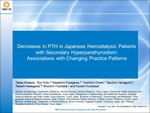 [Decreases in PTH in Japanese Hemodialysis Patients with Secondary Hyperparathyroidism : Associations with Changing Practice Patterns]
[Decreases in PTH in Japanese Hemodialysis Patients with Secondary Hyperparathyroidism : Associations with Changing Practice Patterns]![Prescription Patterns and Mineral Metabolism Abnormalities in the Cinacalcet Era : Results from the MBD-5D study] (interim analysis for 1.5 years](../../images/activities/research/mbd-5d_006en.jpg) [Prescription Patterns and Mineral Metabolism Abnormalities in the Cinacalcet Era : Results from the MBD-5D study] (interim analysis for 1.5 years]
[Prescription Patterns and Mineral Metabolism Abnormalities in the Cinacalcet Era : Results from the MBD-5D study] (interim analysis for 1.5 years]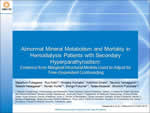 [Abnormal Mineral Metabolism and Mortality in Hemodialysis Patients With Secondary Hyperparathyroidism : Evidence from Marginal Structural Models Used to Adjust for Time-Dependent Confounding]
[Abnormal Mineral Metabolism and Mortality in Hemodialysis Patients With Secondary Hyperparathyroidism : Evidence from Marginal Structural Models Used to Adjust for Time-Dependent Confounding]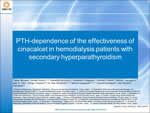 [PTH-dependence of the effectiveness of cinacalcet in hemodialysis patients with secondary hyperparathyroidism]
[PTH-dependence of the effectiveness of cinacalcet in hemodialysis patients with secondary hyperparathyroidism]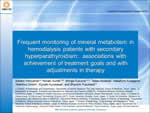 [Frequent monitoring of mineral metabolism in hemodialysis patients with secondary hyperparathyroidism : associations with achievement of treatment goals and with adjustments in therapy]
[Frequent monitoring of mineral metabolism in hemodialysis patients with secondary hyperparathyroidism : associations with achievement of treatment goals and with adjustments in therapy]





 Click here for English version
Click here for English version







